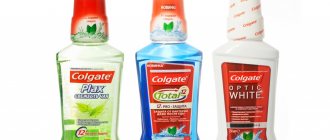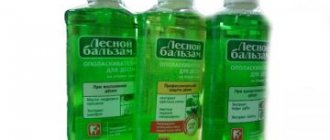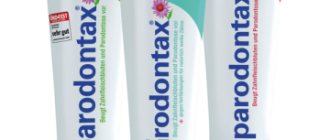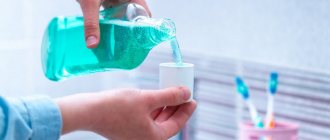From this article you will learn:
- how to choose a rinse for teeth and gums,
- rating of mouthwashes 2022.
- reviews of Listerine, Elmex, Lakalut, President, etc.
The article was written by a dentist with more than 19 years of experience.
Mouth rinses are excellent means of caring for teeth and gums, but they can only be considered as additional care, and their use cannot replace mechanical brushing of teeth (using a toothbrush and toothpaste). They are especially recommended for patients who do not use dental floss to regularly clean interdental spaces and do not brush their teeth after every meal. In children, rinses can be used from 6-7 years of age.
Modern mouthwashes, as a rule, no longer contain alcohol (as a solvent and preservative), and components such as sodium lauryl sulfate and parabens. However, mouth rinses cannot be called a completely safe product – when it comes to their long-term use. And in this article we will talk not only about the criteria for choosing the best mouthwash, but also how they affect the mucous membrane and microflora of the oral cavity.
The article’s author’s favorite mouthwash is
Most types of mouth rinses are designed to strengthen teeth and protect them from caries. Other products may be intended to treat or prevent inflammation of the gums, to reduce tooth sensitivity, for halitosis (bad breath), and to reduce symptoms of xerostomia (dry mouth). A large group of rinses has a combined composition that can allow you to simultaneously act on several problems in the oral cavity.
Children can use mouthwash from 6-7 years of age. This is due to the fact that in young children the swallowing reflex is not yet fully controlled, and therefore involuntary swallowing of the mouthwash is possible. Which is not very safe.
How to choose the right mouthwash -
This article was written by a dentist, and its main goal is to teach you how to navigate the compositions of mouth rinses from different manufacturers so that you can choose the most optimal product for you. Below you will find a rating of the best rinses for teeth and gums for 2022 (+ recommendations for their use).
First, we will talk about how to choose the best rinse for dental caries, and then we will move on to other products that can be used for gum inflammation, to relieve hypersensitivity, or to whiten teeth.
1) Protection against caries (with fluoride and xylitol) –
Fluoride rinses can provide the strongest protection against caries. Components such as sodium fluoride or amino fluoride (in concentrations from 230 to 450 ppm, but on average 250 ppm) can be used as fluorides. The mechanism of anti-caries protection of fluoride-containing products is very interesting. The fact is that fluoride ions bind to the crystals of “hydroxyapatite”, which makes up the enamel of teeth, turning them into “fluorine-hydroxyapatite”.
You probably know that cariogenic bacteria convert food debris into acids, which lead to the dissolution of hydroxyapatite in tooth enamel and, accordingly, to the formation of a carious defect. Tooth enamel usually begins to dissolve at an acidity pH of 5.5 or lower. But if the surface layer of enamel contains fluoride, then tooth decay begins only at a lower pH value of 4.5 (i.e., at a much higher acid concentration!).
Sodium fluoride and amino fluoride (synonym - olaflur) are the best fluoride compounds, and amino fluoride is the most effective. You can rinse your mouth with amino fluoride for only 30-45 seconds, while with sodium fluoride - for 45-60 seconds. This is due to the fact that in the oral cavity aminofluoride dissociates more quickly with the release of active fluoride ions than sodium fluoride and, even more so, than monofluorophosphate (the latter is effective if you rinse your mouth with it for at least 1.5-2 minutes).
Important: but not only fluoride can provide anticaries effect. Additional anti-caries protection can be provided by xylitol (synonym - xylitol), which can also be included in mouthwashes from some manufacturers. Xylitol effectively inhibits the growth of carious bacteria and reduces acidity in the oral cavity, however, the anti-carious effect of xylitol is significantly inferior to that of fluorides.
2) Anti-caries rinses (without fluoride) –
Some anti-caries rinses may not contain fluoride, and a combination of “calcium compound + xylitol” may be used instead. As calcium compounds, the ROCS company uses a combination of “calcium lactate and calcium glycerophosphate,” and the SPLAT company uses a combination of “calcium lactate + ultrafine hydroxyapatite.” In addition, ROCS rinses contain a high concentration of xylitol.
When compared with the anti-caries effectiveness of fluoride rinses, these products will certainly be less effective in preventing dental caries. In addition, such products are more effective only after brushing your teeth, and not in the middle of the working day after eating. The fact is that within 1-2 hours after brushing your teeth, a biofilm consisting of oral bacteria, as well as proteins and carbohydrates, forms on them. Such a biofilm will prevent the penetration of calcium ions into tooth enamel.
In turn, fluoride ions have a higher penetrating ability through the biofilm, and in addition, they themselves have an antibacterial effect, inhibiting the growth of microbial plaque. In addition, there is another important point that depreciates mouth rinses with calcium (without fluoride).
Important: if you use rinses immediately after brushing your teeth in the morning and evening, then it makes no sense to use a rinse with calcium after brushing your teeth with fluoride paste (there is a rule “first calcium - then fluoride”). In this case, you would have to first brush your teeth with a calcium-free, fluoride-free toothpaste, and then use a calcium-free, fluoride-free mouthwash. But this also makes no sense.
It would be logical to first brush your teeth with a paste containing calcium compounds (without fluoride), and immediately after that, rinse your mouth for 40-60 seconds with a fluoride rinse. In this case, calcium ions first penetrate into the tooth enamel and are then sealed there with fluoride ions, and this combination is the most effective protection against caries. If you use a mouthwash after lunch in the middle of the working day (instead of dental floss), it is better to again use a mouthwash with fluoride (+ xylitol).
Rinse aid composition
Stay up to date! Parodontax antiseptic solutions contain the following components:
- Chlorhexidine is a drug that has antibacterial and disinfectant properties. Chlorhexidine is active against certain strains of bacteria, viruses and yeast. But it is not recommended for long-term use, as it can cause an unpleasant odor and irritation of the mucous membranes and gums. For this reason, the rinse aid should be used for no more than 21 days.
- Sodium fluoride – has a detrimental effect on pathogenic microorganisms, prevents the formation of tartar and effectively protects enamel from destruction.
- Propylparaben and methylparaben - cause the death of pathogens that contribute to the development of caries, and are considered the most harmless of all parabens.
- Sodium saccharinate is a safe artificial sweetener approved for use in all food products.
- Propylene glycol is an organic compound used as a solvent.
- Eugenol is a substance obtained from essential oils with a pronounced clove aroma.
- Castor oil is a natural anti-inflammatory that can eliminate bleeding gums.
- Sorbitol is a sweetener added to give the solution a pleasant sweet taste.
It is worth noting! A feature of Parodontax therapeutic and prophylactic rinses is the absence of alcohol, which dries out and irritates the oral mucosa.
Mouthwashes for caries prevention –
The best fluoride compound in mouthwashes is aminofluoride (synonym: olaflur), and in second place is sodium fluoride. These compounds have the highest anti-caries effectiveness, but it is necessary to take into account not only the type of fluoride compound, but also its concentration. In addition, you will not see antiseptics, antibiotics or alcohol in the anti-caries rinses we have chosen, which means that their use on an ongoing basis will not cause harm to your health.
1) ELMEX “Protection against caries” mouthwash
- manufacturer: Germany/Poland,
- active ingredients – aminofluoride (olaflur) + sodium fluoride,
- fluorine content – 250 ppm,
- does not contain alcohol,
- price: 400 ml – from 250 to 350 rubles.
Comments: ELMEX series toothpastes and rinses are a professional line of oral hygiene products from Colgate®, which belongs to the pharmacy range. The products in this series contain more expensive and high-quality active ingredients (and higher concentrations) - compared to other products of this company. In our opinion, the Elmex “Protection against Caries” rinse is one of the best mouth rinses for the prevention of caries, which can be used in adults and children from 6 years of age.
Usage regimen: 2 times a day, morning and evening (breakfast/dinner → brushed teeth → rinsed mouth). It is especially good if, before using the mouthwash, you brushed your teeth with a toothpaste based on a combination of calcium compounds (without fluoride), for example, calcium lactate, calcium pantothenate, calcium glycerophosphate and hydroxyapatite. As we said above, this strategy of using calcium/fluoride provides the highest anti-caries protection.
Or you can use it once a day in the middle of the working day (for example, immediately after lunch). But in this case, it will be even better if you also use dental floss to clean the interdental spaces before the rinse. Rinse time – 30-45 seconds. For rinsing the mouth, 10 ml of the drug is enough. After spitting the solution, do not rinse your mouth with water under any circumstances (the effectiveness will be higher).
2) Rinse aid PRESIDENT PROFI Classic “For daily care”
manufacturer: Italy,- active ingredients – sodium fluoride + xylitol, as well as extracts of sage, lemon balm and chamomile,
- total fluoride content – 450 ppm,
- does not contain alcohol,
- price for 250 ml – from 250 rubles.
Comments: PRESIDENT PROFI Classic Series Mouthwash “For Daily Care” - contains the highest dosages of sodium fluoride and xylitol (xylitol) available on the market. Thus, the product has a very powerful anti-caries effect, and also contains anti-inflammatory extracts of medicinal plants. This mouthwash is as good as the ELMEX Anti-Caries Mouthwash, and in some aspects it is even better.
The only difference between PRESIDENT PROFI Classic is that it will require a slightly longer rinse (about 40-60 seconds), instead of 30-45 seconds for Elmex. If you take a mouthwash to use after lunch in the middle of the day, we would even put PRESIDENT PROFI Classic in 1st place (since the presence of xylitol will also reduce acidity in the oral cavity). And do not forget that in this case, before using the mouthwash, it is advisable to use dental floss to clean the interdental spaces from food debris.
Mouthwashes for sensitive teeth –
Mouthwashes to reduce tooth sensitivity may contain 2 types of active ingredients.
Firstly, these are fluorides, which include sodium fluoride, amino fluoride (olaflur) and potassium fluoride. These components work by creating a layer of calcium fluoride on the surface of the enamel, which protects teeth from the influence of chemical, thermal and mechanical irritants. However, the effect of using this group of components develops gradually. The second group of substances includes potassium compounds - such as potassium nitrate and potassium fluoride, which work by reducing the sensitivity of nerve endings in dental tissues. This group of substances acts more quickly, but the effect will disappear immediately after using the product. Therefore, ideally, rinses contain a combination of active substances: both fluorides and potassium compounds.
Rinse aid ELMEX “Sensitive Plus” –
manufacturer – Germany,- active substances are aminofluoride, potassium fluoride, as well as “dimethyl-amino-ethyl methacrylate-polycarbamyl-polyglycol”.
- fluoride content – 250 ppm,
- price for 400 ml – from 260 rubles.
Comments: in our opinion, Elmex Sensitive Plus is one of the best rinses for reducing dental hypersensitivity. It contains amino fluoride, the substance potassium fluoride (which, upon dissociation, decomposes to form active fluoride ions and potassium ions), as well as a special polymer “dimethyl-amino-ethyl methacrylate-polycarbamyl-polyglycol”, which creates a protective biofilm on the surface of the tooth. Ideally, combine this product with Lacalut Extra Sensitive toothpaste.
Rinse aid PRESIDENT “Sensitive Plus” –
manufacturer – Italy,- active ingredients – potassium nitrate, calcium lactate, xylitol, as well as linden and chamomile extracts,
- fluoride content – without fluorine,
- price for 300 ml – from 220 rubles.
Comments: PresiDent Sensitive Plus rinse contains a very high dosage of potassium nitrate, which ensures rapid reduction of hypersensitivity. In addition, the product contains calcium lactate to increase the mineralization of tooth enamel, as well as a high concentration of xylitol (it neutralizes acid in the oral cavity, thereby inhibiting the demineralization of teeth, and ultimately also indirectly helps reduce hypersensitivity.
Important: We would like to point out that mouthwashes to reduce dental hypersensitivity are only a secondary treatment for this problem. They do not allow achieving a greater effect than can be achieved with special toothpastes and concentrated gels used for increased tooth sensitivity. Such rinses are a good option for use in the middle of the working day, and in the morning and evening it is better to use toothpaste for these purposes.
Operating principle
Reference! When Parodontax medicinal rinse gets into the oral cavity, the active components of the antiseptic have a detrimental effect on the membrane of harmful bacteria.
This helps remove them from the teeth, gums and inside of the cheeks .
The active ingredients also create a barrier that prevents the development of pathological processes, help thoroughly clean teeth from plaque and strengthen gums.
Using mouthwash alone is not enough to cleanse your mouth.
Without first brushing your teeth, the product will not be able to eliminate inflammatory processes, but will only mask the problem by removing external signs.
Features of the use of rinses -
Typically, mouth rinse is used 2 times a day (morning and evening - immediately after meals and subsequent brushing of teeth). The second option is that you can use the mouthwash immediately after lunch in the middle of the working day, but in this case, before rinsing, it is advisable to clean the interdental spaces from food debris using dental floss. We have listed the basic rules below.
Scheme for using mouth rinses -
- For rinsing, 10 ml of solution is enough (15-20 ml may be written on the rinse aid packaging, but this is only for the purpose of making you buy a new package faster),
- rinsing time averages from 45 to 60 seconds (the exact time depends on the type of rinse aid, and will be written on the product packaging; some types of rinses without alcohol and antiseptics, for example, Parodontotsid, 2-3 minutes are recommended),
- after spitting the solution, you should not rinse your mouth with water, eat for several hours, or drink for at least 30 minutes (this is a desirable rule that will increase the effectiveness of the procedure, but not mandatory),
- do not use rinses with alcohol, as well as products with antiseptics or antibiotics - more than 10-14 days (in this case you will get side effects).
Instructions for use
Remember! To ensure high-quality cleansing of the oral cavity using Parodontax rinse after regular teeth brushing, you must:
- Open the bottle equipped with a measuring cup and fill the container with 10 ml of medicinal liquid.
- Place the product in your mouth, undiluted with water or other liquids, and rinse for a minute.
- After rinsing your mouth, spit out the liquid. There is no need to rinse your mouth additionally.
After using the product, slight temporary staining of tooth enamel may occur , which can be easily cleaned.
Mouthwashes - side effects
Mouth rinses contain only surfactants that cannot penetrate the oral mucosa and enter the bloodstream unless, of course, you swallow them. But nevertheless, mouth rinses are not as safe as they might seem, and the maximum negative effect develops with prolonged use.
What you need to pay attention to. Firstly, it is better to avoid products containing alcohol, because... with prolonged use, this leads to thinning and dryness of the oral mucosa. The second point is that if you have allergic manifestations on the mucous membrane of the oral cavity, then it is better to avoid rinses with parabens (for example, preservatives such as methylparaben or ethylparaben). Parabens cause oral allergies in approximately 4% of people.
If you periodically experience stomatitis (aphthous or herpetic), we recommend avoiding rinses with sodium lauryl sulfate. By itself, this component cannot cause stomatitis, but it leads to accelerated desquamation (squamation) of the epithelium of the oral mucosa, which makes the mucosa thinner and more vulnerable. It has been noticed that when using oral hygiene products with lauryl sulfate, outbreaks of stomatitis occur more often, and ulcerations of the mucous membrane take a longer time to heal.
Side effects of rinses with Chlorhexidine -
But most of the side effects are associated with long-term use of Chlorhexidine, which is included in almost every rinse for gum inflammation or bad breath. Reputable clinical studies (source) have revealed that within 7 days from the start of rinsing the mouth with chlorhexidine, global changes occur in the microflora of the mouth. Positive changes relate to the fact that chlorhexidine suppresses pathogenic bacteria that cause gum inflammation and bad breath.
But there are also negative aspects. A course of rinsing the mouth with chlorhexidine (reducing the number of some types of bacteria) simultaneously led to an increase in the number of other types of bacteria. Changing the ratio of different types of bacteria in the oral cavity has its consequences. For example, as a result of this, there was an increase in the content of lactic acid in the oral fluid (saliva), which led to a decrease in the buffer capacity of saliva and its ability to neutralize the acid produced by cariogenic bacteria in the oral cavity. Research clearly showed that chlorhexidine rinses led to a decrease in the pH of the oral fluid (i.e., its acidity increased).
And this is very important, because... a decrease in the pH of the oral fluid triggers the process of demineralization of tooth enamel, which significantly increases the risk of developing dental caries. Above we told you about the PRESIDENT Antibacterial rinse “Powerful protection against bacteria”, which contains 0.2% chlorhexidine - in combination with xylitol (xylitol). In this case, xylitol neutralizes the negative effects of chlorhexidine, because it has the property of reducing the acidity of oral fluid. This is also why we consider this mouthwash one of the best for treating gum inflammation.
Important: but that’s not all! Research has shown that chlorhexidine interferes with the ability of oral bacteria to convert nitrates (found in foods) into nitrites. This bacterial activity is called “nitrate-reducing” and is important for maintaining normal blood pressure. The fact is that nitrites help lower blood pressure, and accordingly, a decrease in the production of nitrites by oral bacteria leads to an increase in blood pressure.
This issue is important primarily for patients with chronic cardiovascular pathology. The above points are confirmed by the scientific study “The increase in plasma nitrite after a dietary nitrate load is markedly attenuated by an antibacterial mouthwash. Nitric Oxide" (2008), authors – Mirco Govoni, Emmelie Å. Jansson, Eddie Weitzberg, Jon O. Lundberg. If you wish, you can read this study using the link above using a browser translator.
Teeth whitening rinses –
This is the last group of funds that we would like to talk about. The fact is that such rinses may contain not only completely harmless, but also quite dangerous components. For example, common “whitening components” include: 1) the enzymes bromelain and papain, which dissolve the protein matrix of plaque, 2) polyphosphates prevent plaque from adhering to the teeth - sodium hexametaphosphate and trisodium phosphate, 3) pyrophosphates and polydone prevent the mineralization of plaque, t .e. its transformation into tartar.
All these components are also found in toothpastes (in certain combinations). But what should never be in rinses is carbamide peroxide/hydrogen peroxide. For example, some ROCS rinses contain “hydrogen peroxide 1.0%” (hydrogen peroxide) to implement the oxygen bleaching mechanism. These components are widely used in professional products - in special whitening trays with gel, whitening strips, etc. But an important condition for use is that the gums are isolated from contact with the gel containing peroxide.
There is a clinical study (“The myth of oral hygiene using synthetic mouthwash products,” 2016). It clearly shows that even small concentrations of peroxides in mouth rinses can lead to mutations in the DNA of cells in the oral mucosa. Those. in this case, we are talking about the fact that such rinses increase the risk of developing cancer, and this risk will be highest in smokers. We hope that our review of mouthwashes was useful to you!
Sources:
1. Dental education of the author of the article, 2. National Library of Medicine (USA), 3. PubMed.gov scientific research database, 4. Official websites of manufacturers of oral hygiene products.
Feedback about use
Below are some customer reviews. If you have something to say, leave your feedback in the comments below the article, it will be useful to our readers.
I have been using Parodontax Classic mouthwash for three years in courses on the advice of a dentist.
The liquid copes well with plaque, reduces bleeding and reduces inflammation. During the procedure, the product burns the gums a little, especially the inflamed areas, but the discomfort quickly passes.
After rinsing, an unobtrusive menthol taste remains in the mouth, which disappears after 5 minutes, the breath becomes fresh, and the teeth are perfectly clean.
In addition to toothpaste and floss, I always use mouthwash. Due to problems with gums, I periodically buy Parodontax Extra to treat inflammatory diseases.
An excellent product that completely eliminates swelling and bleeding. It cannot be used for prevention, as my doctor said.
The taste is not the most pleasant for me, but if you consider this rinse as a medicinal product, then you can tolerate it a little.








